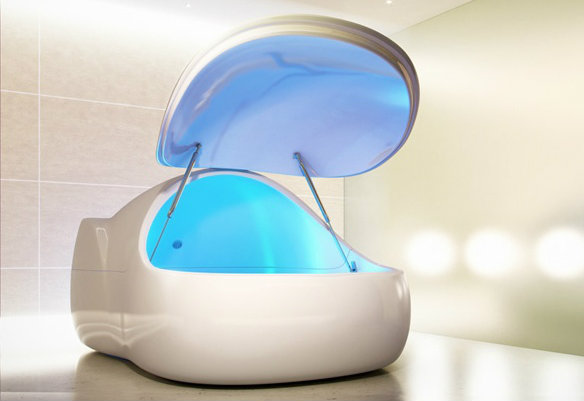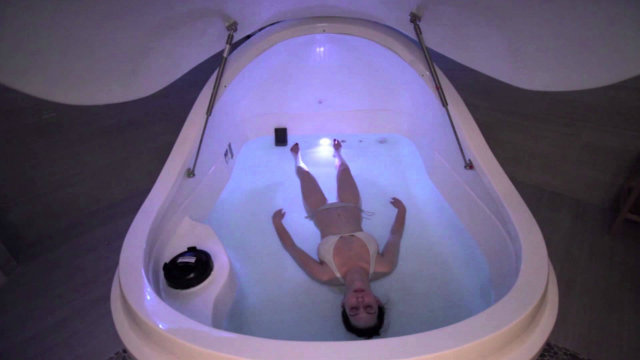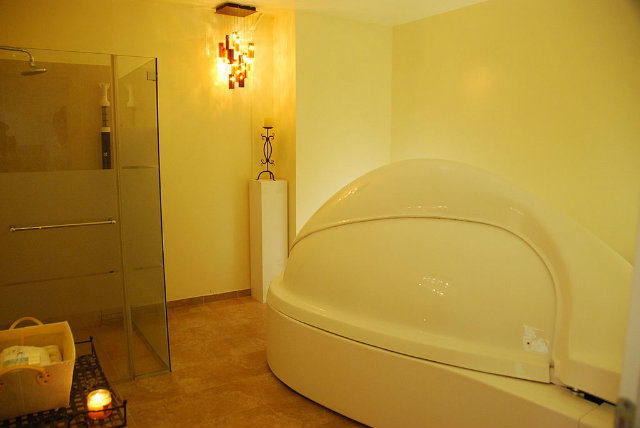 Reading Time: 9 minutes
Reading Time: 9 minutesI recently had the opportunity to try a new form of stress relief called flotation therapy. I know the idea of flotation therapy sounds strange, even I was skeptical as to what to expect. The idea of sitting still for an entire hour inside a pod in a dark room didn’t exactly pique my interested immediately, but based on the purported benefits, I decided to give it a shot and visited a business called the Float Centers of Nevada.
To my surprise, I walked out of the session stress free and pain free. Sitting still was not easy at first, but after about ten minutes I was able to relax and enjoy the silence. It was like the world went quiet, and that seemed to be what I truly needed. The sensation of the suspension in the highly salted water was like being on a cloud.
As someone with rheumatoid arthritis and who has to deal with pain occasionally, I found this to be an interesting and effective form of therapy. There are three areas that float therapy impacts that I would like to discuss in case it may benefit you — stress relief, mental health, and pain relief — but first a little context.
History of the Float Tank and Its Function
Neuroscientist, Dr. John Lilly developed flotation therapy in the 1950s in order to create sensory deprivation. When we think about how we are in the outside world, very seldom is it quiet or free of sensation. Much of the time, we as humans are on sensory overload. We rush from our job, find time to workout, come home to cook dinner or prepare meals, and then, if we are lucky, fall asleep for about half the recommended time we are supposed to, and even then, we very seldom ever reach the deepest levels of sleep. Sound familiar to you?
Flotation therapy is also known as a form of REST, or restricted environmental stimulation technique. Float therapy basically cuts us off from the outside world in order to cut down on stress and help us reach certain brainwave patterns, usually theta patterns, that we normally can’t reach when we are over stimulated. Theta brainwave patterns are reached when our brains are extremely relaxed, under hypnosis, and in REM sleep. The theta wave state is the phase in which we normally begin dreaming.
A float tank uses roughly 1,200 pounds of Epsom salt so a person can float inside of a tank. The time spent in the tank depends on each particular business, but in most cases it is sixty minutes in the tank, with a full ninety minutes allocated for the actual session to allow for getting in and out of the tank.
There are different types of float tanks, some are rectangular in shape others are like pods. Each type has a door that closes to reinforce the REST concept (by the way, if you are claustrophobic, you should know that you can easily leave this door open slightly). As far as which type would be best for you, it really depends on the person. I personally enjoy the pods.
Flotation Therapy and Hormone Response
There is an effect on our hormones when using this method of relaxation technique. According to the Biofeedback Self Regulation Journal, there can be marked differences in cortisol. Cortisol is known as the stress hormone, and it is a glucocorticoid, which means it is also classified as a steroid. Cortisol has a purpose when our bodies are under stress — it increases our blood sugar levels via gluconeogenesis (the creation of glucose) to give us energy in times of emergency. But if our bodies are under a constant state of stress, it can increase our cortisol levels when they are not needed, and this causes weight gain and increased blood sugar levels.
The study explained in the Biofeedback Self Regulation Journal had each subject go through two baseline sessions, four REST or non-REST relaxation sessions, and then two follow-up sessions, for a total of eight sessions. Pre- and post-session plasma hormone levels were measured during the baseline sessions, the fifth relaxation session, and the final follow-up session.
During the treatment period, or the fifth session, the pre- to post-session changes in cortisol were significantly greater for the REST group than the non-REST group. The plasma cortisol levels decreased across sessions in the REST group, with the fifth and eighth session being significantly lower than the baseline tests. Non-REST subjects showed no change in plasma cortisol levels. The data shows that repeated sessions of REST-assisted relaxation (flotation therapy) produce a relaxation state in line with decreases in adrenal cortex activity.
Flotation Therapy and Osteoarthritis
Some studies have found there is a correlation between flotation therapy and pain relief, not just for those with osteoarthritis but for a range of issues from muscle soreness to rheumatoid arthritis.
Complementary Therapies in Medicine set out to see if flotation therapy could help those with osteoarthritis. Fourteen patients with chronic osteoarthritis were sent to a private floatation therapy center. The intervention included six weekly session of flotation therapy. To gauge how the flotation therapy was affecting the subject a quality of life questionnaire was given to each person.
The results showed that all patients improved. The differences between the baseline and discharge scores showed significant improvements in MYMOP, or “measure yourself medical outcome profile.” Based off this study, more controlled trials of flotation therapy are warranted for patients with osteoarthritis.
Other studies have been done using flotation therapy for rheumatic patients that showed a decrease in pain because of lower blood pressure levels and decreased stress levels.
Flotation Therapy and Mental Health
REST through flotation therapy can help with a host of mental health issues such as anxiety, PTSD, ADD, and ADHD. A study conducted by the Open Journal of Medical Psychology set out to see how flotation therapy could help those afflicted with mental health issues. (Note: this study only used one subject, but the important aspect to remember is that this test could be replicated with a larger sample size.)
A 24-year old woman with diagnosed ADHD, atypical autism, PTSD, anxiety, and depression was to report her experiences from a year and a half of consistent flotation therapy. She was interviewed about her experiences over the course of this time period and her interviews were analyzed.
The results showed that with regular flotation therapy the subject had a sense of an improved quality of life, well-being, and healthy behaviors. She experienced no negative effects from the flotation therapy. These results suggest that regular flotation therapy can have positive and beneficial effects on mental health. Further studies need to be conducted to evaluate the efficacy of this therapy.
Flotation Therapy Is Available for Everyone
Even though flotation therapy has been around for quite some time, it is increasing in popularity. Flotation centers are opening up all over, and most offer a discounted rate for first-time users. The amazing thing about flotation therapy is anyone can use it without risking any known negative side effects. Athletes can use this technique on rest days to unwind from difficult weeks or after competition. The everyday person can use flotation therapy to disconnect from the world and have a better sense of well-being. Flotation therapy can help with pain in those with chronic illness.
I know some of you are probably thinking, “Can I sit still for sixty minutes?” You may fidget for the first few minutes, but I believe you will be pleasantly surprised to see how much your body needs REST in general, and how your body tends to go with the flow of its environment.
If you decide to float, there are some important things to keep in mind:
- You should not shave the day of your float. It will not feel pleasant and could irritate your skin.
- I suggest you do not drink any caffeine the entire day of your float, but most people recommend not drinking any caffeine for four to six hours prior to a session.
- You will need to shower before and after your float session, so bring basic toiletries with you.
- Find a time that fits your schedule. You will need to budget around ninety minutes of your time to flotation therapy. Don’t be stressing about relaxing!
- I don’t recommend scheduling a float session before work. If you are going to float, do it after work or on the weekend and after your workout.
My Experience with Flotation Therapy
Every person’s experience with float therapy will be slightly different. But the first time I tried it, I became a believer, even if some of it might be psychosomatic (though studies are showing this is not the case in all situations).
Some people get nervous they might flip over or get water in their ears, but in my experience, you will not flip and if you do, it’s not a problem because the water is super shallow. In addition, most establishments offer earplugs so you don’t get water in your ears during the session.
My first float was the most difficult, but after that it became easier to just float with a clear mind. I didn’t think about anything, and as strange as this may sound, I was ecstatic about this fact. Every waking moment in life seems to involve thinking about what to do next, but during flotation therapy, this was not the case.
I personally float in the evenings because of how relaxed it makes me. I usually have a hard time sleeping. I am an insomniac by nature, but after my float session, I slept a full eight hours, which is very rare for me. Now, flotation therapy is part of my regular routine, like exercise, yoga, massage, physical therapy, and nutrition therapy.
Flotation therapy continues to help with my rheumatoid arthritis, mental health, and sleep. It has been a fantastic supplemental therapy for my overall health and well-being. I hope flotation therapy is something you will try – it doesn’t hurt to try something once. You may find that you really enjoy the experience. Happy floating!
References:
1. Turner, JW & Fine, TH, “Effects of Relaxation Associated with Brief Restricted Environmental Stimulation Therapy (REST) on Plasma Cortisol, ACTH, and LH,” Biofeedback Self Regulation Journal 8, no. 1 (1984): 115-26, accessed April 12, 2016, DOI: 10.1007/BF01000542
2. Hill, S, et. al. “A Pilot Study to Evaluate The Effects of Flotation Spa Treatment on Patients with Osteoarthritis,” Complementary Therapies in Medicine 7, no. 4 (1999): 235-38, accessed April 12, 2016, DOI: 10.1016/S0965-2299(99)80008-9
3. Kjellgren, A. et. al. “Quality of Life with Flotation Therapy for a Person Diagnosed with Attention Deficit Disorder, Atypical Autism, PTSD, Anxiety, and Depression,” Open Journal of Medical Psychology 2, no. 3 (2013): 5, accessed April 12, 2016, DOI: 10.4236/ojmp.2013.23020
4. Powers, Scott & Howley, Edward, Exercise Physiology: Theory and Application to Fitness and Performance. (New York: McGraw Hill Education, 2015), 101
5. Tate, Philip, Seely’s Principles of Anatomy and Physiology. (New York: McGraw Hill Education, 2012): 450
Photo 1 by Floatguru (Own work) [CC BY-SA 3.0], via Wikimedia Commons
Photo 3 by rl2011.Rl2011 at he.wikipedia [CC BY-SA 3.0 or GFDL], from Wikimedia Commons








